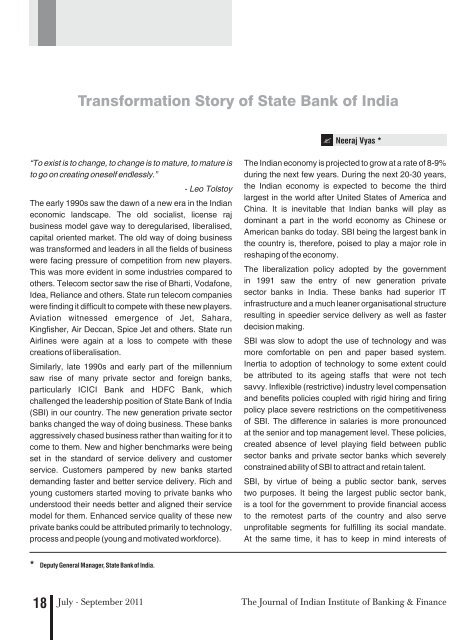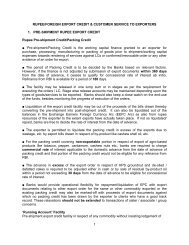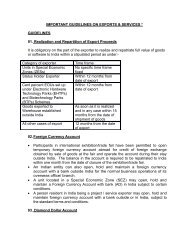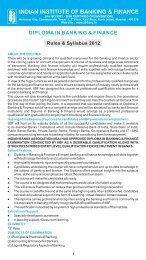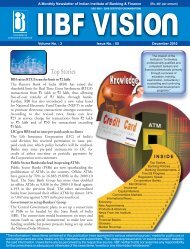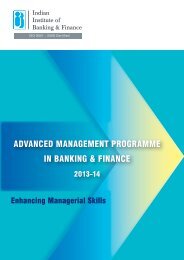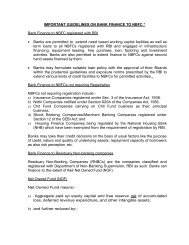Keb[ / DebkeÀ / pegueeF& - efmelebyej /
special feature - Indian Institute of Banking & Finance
special feature - Indian Institute of Banking & Finance
- No tags were found...
You also want an ePaper? Increase the reach of your titles
YUMPU automatically turns print PDFs into web optimized ePapers that Google loves.
special featureTransformation Story of State Bank of IndiaNeeraj Vyas *“To exist is to change, to change is to mature, to mature isto go on creating oneself endlessly.”- Leo TolstoyThe early 1990s saw the dawn of a new era in the Indianeconomic landscape. The old socialist, license rajbusiness model gave way to deregularised, liberalised,capital oriented market. The old way of doing businesswas transformed and leaders in all the fields of businesswere facing pressure of competition from new players.This was more evident in some industries compared toothers. Telecom sector saw the rise of Bharti, Vodafone,Idea, Reliance and others. State run telecom companieswere finding it difficult to compete with these new players.Aviation witnessed emergence of Jet, Sahara,Kingfisher, Air Deccan, Spice Jet and others. State runAirlines were again at a loss to compete with thesecreations of liberalisation.Similarly, late 1990s and early part of the millenniumsaw rise of many private sector and foreign banks,particularly ICICI Bank and HDFC Bank, whichchallenged the leadership position of State Bank of India(SBI) in our country. The new generation private sectorbanks changed the way of doing business. These banksaggressively chased business rather than waiting for it tocome to them. New and higher benchmarks were beingset in the standard of service delivery and customerservice. Customers pampered by new banks starteddemanding faster and better service delivery. Rich andyoung customers started moving to private banks whounderstood their needs better and aligned their servicemodel for them. Enhanced service quality of these newprivate banks could be attributed primarily to technology,process and people (young and motivated workforce).The Indian economy is projected to grow at a rate of 8-9%during the next few years. During the next 20-30 years,the Indian economy is expected to become the thirdlargest in the world after United States of America andChina. It is inevitable that Indian banks will play asdominant a part in the world economy as Chinese orAmerican banks do today. SBI being the largest bank inthe country is, therefore, poised to play a major role inreshaping of the economy.The liberalization policy adopted by the governmentin 1991 saw the entry of new generation privatesector banks in India. These banks had superior ITinfrastructure and a much leaner organisational structureresulting in speedier service delivery as well as fasterdecision making.SBI was slow to adopt the use of technology and wasmore comfortable on pen and paper based system.Inertia to adoption of technology to some extent couldbe attributed to its ageing staffs that were not techsavvy. Inflexible (restrictive) industry level compensationand benefits policies coupled with rigid hiring and firingpolicy place severe restrictions on the competitivenessof SBI. The difference in salaries is more pronouncedat the senior and top management level. These policies,created absence of level playing field between publicsector banks and private sector banks which severelyconstrained ability of SBI to attract and retain talent.SBI, by virtue of being a public sector bank, servestwo purposes. It being the largest public sector bank,is a tool for the government to provide financial accessto the remotest parts of the country and also serveunprofitable segments for fulfilling its social mandate.At the same time, it has to keep in mind interests of* Deputy General Manager, State Bank of India.18July - September 2011The Journal of Indian Institute of Banking & Finance


